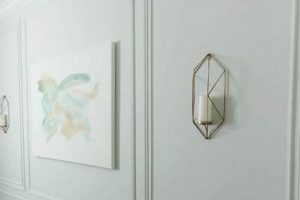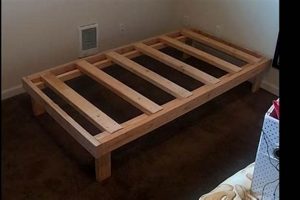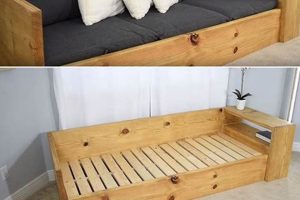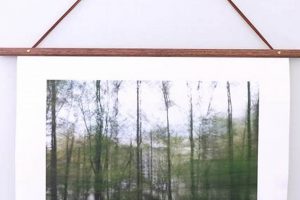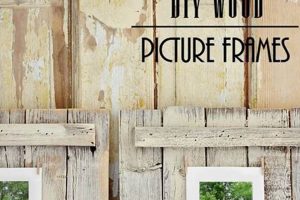Constructing a border for a stretched fabric artwork utilizes wood as its primary material. This process involves measuring the artwork, cutting wood pieces to size, assembling the frame, and securing the canvas within it. These frames provide structural support and enhance the aesthetic presentation of the artwork. An example would be building a simple rectangular structure to surround an oil painting on stretched linen.
Such frameworks serve a crucial function by protecting the canvas edges from damage and providing a means for hanging the artwork. Historically, frames were considered integral to the painting, often designed and crafted specifically for a particular piece, reflecting the artistic and cultural values of the time. The use of these handcrafted borders allows for customization to match interior design or personal aesthetic preferences, increasing the artwork’s visual appeal and market value.
The subsequent sections will detail the specific materials required, the step-by-step construction process, various finishing techniques, and tips for ensuring a professional-looking result. Considerations for different canvas sizes and frame styles will also be addressed, providing a comprehensive guide for constructing such a border at home.
Construction Guidance
The following guidelines enhance the quality and longevity of a handcrafted border for stretched fabric artworks. Adherence to these recommendations ensures a structurally sound and aesthetically pleasing final product.
Tip 1: Precise Measurement: Accurate measurement of the canvas is essential. Inaccurate dimensions lead to a frame that is either too tight or too loose, compromising the integrity of the artwork and the frame itself. Double-check all measurements before cutting any wood.
Tip 2: Wood Selection: Employ kiln-dried wood to minimize warping or twisting over time. Softwoods such as pine are cost-effective and easy to work with, while hardwoods offer greater durability and a more refined appearance. Consider the wood’s grain and overall aesthetic appeal in relation to the artwork.
Tip 3: Miter Joint Accuracy: Precise 45-degree miter joints are crucial for creating seamless corners. Use a miter saw or a miter box to ensure accuracy. A slight imperfection in the miter angle will result in visible gaps at the corners.
Tip 4: Secure Fastening: Employ wood glue in conjunction with nails, screws, or staples to create strong and durable corner joints. Clamping the corners while the glue dries ensures a tight bond and prevents movement during assembly.
Tip 5: Canvas Securing Methods: Use canvas offset clips or staples to securely attach the canvas to the back of the frame. Ensure the canvas is stretched evenly to avoid wrinkles or sagging. Properly tensioned canvas presents a professional appearance.
Tip 6: Sanding and Finishing: Thoroughly sand all surfaces of the wood frame to create a smooth, uniform finish. Apply a primer to seal the wood and provide a better surface for paint or stain. Select a finish that complements the artwork and the surrounding environment.
Tip 7: Hardware Selection: Choose appropriate hanging hardware based on the size and weight of the framed canvas. D-rings and picture wire are suitable for smaller pieces, while heavier canvases may require more robust hanging systems.
These recommendations serve as fundamental principles for constructing a handcrafted border for stretched fabric artwork. Consistent application of these guidelines promotes durability, aesthetic appeal, and long-term preservation of both the frame and the enclosed artwork.
The concluding section will summarize the key processes and materials, emphasizing the importance of careful planning and execution for optimal results.
1. Materials
The selection of materials is foundational to the structural integrity and aesthetic qualities of a border constructed for stretched fabric artwork. Choosing appropriate materials directly influences the durability, appearance, and overall success of the project.
- Wood Type
The type of wood used dictates the frame’s strength, weight, and susceptibility to warping. Softwoods like pine are cost-effective and easy to work with, suitable for smaller canvases or when a rustic aesthetic is desired. Hardwoods such as oak or maple offer increased durability and a more refined appearance, ideal for larger or more valuable artworks. For example, a frame constructed from pine might suffice for a small acrylic painting, whereas a large oil painting would benefit from the stability of an oak frame.
- Fasteners
Fasteners are critical for securely joining the wood pieces. Options include nails, screws, staples, and wood glue. The type of fastener should be appropriate for the wood type and the desired level of durability. Screws generally provide a stronger hold than nails, particularly when used in conjunction with wood glue. Insufficient or inappropriate fasteners can lead to structural weakness and eventual frame failure. For instance, using small brad nails to assemble a large frame may result in corner separation over time.
- Finishing Products
Finishing products protect the wood and enhance its appearance. Options include stains, paints, varnishes, and sealants. The choice of finish should complement the artwork and the surrounding environment. A clear varnish can protect the wood while allowing its natural grain to show, while paint can be used to match a specific color scheme. Selecting the wrong finish can detract from the artwork or provide insufficient protection against moisture or UV damage. A water-based paint, as an example, would be more suitable for indoor use.
- Canvas Attachment Materials
Materials such as canvas offset clips and staples are essential for securing the canvas to the frame. These materials must be strong enough to hold the canvas taut without damaging it. The spacing and placement of the clips or staples are crucial for distributing tension evenly and preventing wrinkles or sagging. Insufficient canvas attachment can compromise the artwork’s appearance and longevity. Think of using too few staples, or not tensioning them adequately, which will eventually lead to the canvas warping or falling off the frame.
The careful selection of these materials, tailored to the specific requirements of the artwork and the desired aesthetic, is paramount to the creation of a long-lasting and visually appealing framework for stretched fabric artwork.
2. Measurement
Accurate dimensional assessment is a foundational element in the successful construction of a border for stretched fabric artwork. Precise measurements dictate the fit and overall structural integrity of the finished frame. Inaccurate measurements can lead to aesthetic flaws, structural instability, and potentially damage to the canvas itself.
- Canvas Dimensions
The initial step involves precisely determining the width and height of the stretched canvas. This measurement must account for the outermost edges of the canvas, including any additional material wrapped around the stretcher bars. For instance, a canvas advertised as “16×20″ might actually measure 16 1/8″ x 20 1/4” when accounting for the wrapped edges. Failure to accurately measure these dimensions will result in a frame that is either too tight or too loose, compromising its ability to properly support and protect the artwork.
- Miter Joint Calculations
Once the canvas dimensions are established, the length of each wood piece needs to be calculated, accounting for the 45-degree miter joints that form the corners. An incorrect miter angle will result in gaps or overlaps at the corners, detracting from the frame’s aesthetic appeal and structural strength. Precise calculations ensure that the frame’s inner dimensions match the canvas dimensions. This is especially true if the frame’s edge will be tight to the artwork.
- Depth Considerations
The depth of the frame, or its distance from the front to the back, influences the overall visual effect and the space between the canvas and the wall. This measurement dictates the width of the wood pieces to be used. A deeper frame can provide a more substantial and gallery-like appearance, while a shallower frame may be more suitable for smaller or less prominent artworks. Inaccuracies in the depth measurement can result in a frame that appears disproportionate to the canvas.
- Hardware Placement
The precise positioning of hanging hardware, such as D-rings or wire, is critical for ensuring that the framed artwork hangs straight and securely. Inaccurate placement can lead to the artwork hanging crookedly or being unstable on the wall. Careful measurement and marking are essential for achieving a balanced and secure hanging system. For example, misaligned D-rings will cause the framed canvas to tilt to one side when hung.
These measured processes are intrinsic to achieving a high-quality border. By approaching each phase meticulously, construction can produce frameworks that enhance the presentation and safeguard the longevity of the artwork. The connection between precision and aesthetic and structural success of the project cannot be overstated.
3. Joinery
Joinery represents a critical factor in the construction of a wood frame for canvas artwork. The method employed to connect the individual wood components directly impacts the frame’s structural integrity, aesthetic appeal, and long-term durability. Improper joinery leads to weakened corners, potential separation over time, and a compromised presentation of the artwork. For example, a poorly executed miter joint, lacking precision and adequate adhesive, will create a visible gap, detracting from the overall visual quality and reducing the frame’s resistance to stress.
Several joinery methods are commonly utilized in frame construction, each offering distinct advantages and disadvantages. Miter joints, where the wood pieces are cut at a 45-degree angle to form a 90-degree corner, are frequently employed for their clean, seamless appearance. However, miter joints require precise cutting and secure fastening to prevent separation. Lap joints, where two pieces of wood overlap and are joined together, provide a stronger connection but are less visually appealing. Mortise and tenon joints, involving a projecting tenon that fits into a corresponding mortise, offer superior strength and are often used for high-value or large-scale artworks. The selection of the appropriate joinery technique depends on factors such as the size and weight of the canvas, the desired aesthetic, and the skill level of the constructor. A simple butt joint, relying solely on adhesive and fasteners, is generally insufficient for creating a durable and reliable frame.
The successful execution of joinery requires meticulous attention to detail, precise cutting tools, and appropriate adhesives and fasteners. Clamping the joined components while the adhesive cures ensures a tight bond and prevents movement during assembly. Reinforced joinery techniques, such as adding corner braces or splines, can further enhance the frame’s structural stability. Ultimately, the quality of the joinery directly influences the lifespan and visual impact of the framed artwork. Compromising on joinery to save time or resources is a short-sighted decision that ultimately undermines the value and presentation of the enclosed canvas.
4. Assembly
The aggregation of individual components to form a unified structure represents a crucial stage in the construction of a border for stretched fabric artwork. Effective assembly transforms accurately measured and precisely cut wood pieces into a functional and aesthetically pleasing frame, ready to receive the canvas.
- Component Alignment and Fixture
The correct arrangement of frame pieces is paramount. Misalignment during assembly compromises structural integrity and visual appeal. Clamps and jigs facilitate precise alignment, holding components in position while adhesives cure or fasteners are applied. Inadequate clamping pressure results in gaps or shifts, weakening the joints. For instance, failing to ensure perfect 90-degree angles at each corner results in a trapezoidal frame.
- Adhesive Application and Curing
Wood glue provides a secure bond between frame members. Even and complete application is crucial. Insufficient adhesive diminishes joint strength, while excessive application creates a messy appearance. Clamping during the curing process maintains intimate contact between surfaces, maximizing adhesion. Premature removal of clamps compromises the bond. The correct type of glue for the material being used will further improve the outcome. For example, a PVA glue is ideal for wood, but may not be the right choice for all materials.
- Fastener Integration
Nails, screws, or staples, used in conjunction with adhesive, provide added reinforcement to the joints. The type and placement of fasteners must be appropriate for the size and weight of the frame. Overdriving fasteners damages the wood, weakening the joint. Underdriving leaves fasteners protruding, creating a hazard. Proper countersinking creates a clean, professional appearance.
- Corner Reinforcement Techniques
Strengthening corner joints enhances frame durability. Techniques include corner braces, splines, or biscuits. These reinforcements provide additional surface area for adhesion and resist racking forces. Improperly installed corner reinforcements can actually weaken the joint. For instance, a poorly fitted spline creates stress points, leading to eventual failure. Corner reinforcement is one example of methods that add value to the final product.
These aspects of assembly collectively determine the structural soundness and visual quality of the completed border. The careful and considered execution of each phase ensures a frame that effectively protects and enhances the enclosed canvas, upholding the aesthetic value of the artwork.
5. Finishing
The concluding stage in crafting a wood frame for canvas artwork encompasses the meticulous refinement of its surfaces and application of protective or decorative coatings. This phase significantly influences the frame’s aesthetic appeal, durability, and overall presentation of the enclosed artwork.
- Surface Preparation
Prior to applying any finish, thorough sanding is essential to eliminate imperfections, smooth rough edges, and create a uniform surface. Progressively finer grits of sandpaper are employed to achieve a silky-smooth texture. Failure to adequately prepare the surface results in an uneven finish, accentuating flaws rather than concealing them. For instance, neglecting to sand away scratches or splinters will cause the finish to pool and highlight these imperfections.
- Staining and Coloring
Staining allows the wood grain to remain visible while imparting a desired hue. Selecting a stain that complements the artwork and the surrounding environment is crucial. Uneven application or failure to wipe off excess stain results in blotchy or inconsistent coloration. For example, a dark stain applied unevenly can create a muddy and unappealing appearance, obscuring the wood’s natural beauty.
- Protective Coatings
Varnishes, lacquers, and sealants protect the wood from moisture, UV radiation, and physical abrasion. These coatings enhance the frame’s longevity and prevent damage to the underlying finish. Applying multiple thin coats, with light sanding in between, yields a smoother and more durable surface. Skipping this will leave the product vunerable to damages over time.
- Decorative Embellishments
Gilding, painting, or applying decorative molding adds visual interest and personalizes the frame. These embellishments should complement the artwork without overshadowing it. Overly ornate or poorly executed embellishments can detract from the artwork’s impact. Gilding is an example that adds value and can emphasize certain features of the painting.
Finishing is therefore not merely an aesthetic consideration, but an integral process that safeguards the wood frame and enhances the presentation of the canvas artwork. Careful execution of these steps results in a polished and professional final product, extending the lifespan of the frame and amplifying the visual impact of the art. Selecting high quality products is imperative.
6. Canvas attachment
Securing the canvas to the created border directly influences the artwork’s presentation, preservation, and structural integrity. Improper or insufficient canvas attachment methods compromise the tautness of the canvas, causing sagging, wrinkles, or distortion of the image. The type and placement of fasteners, such as staples or canvas offset clips, must be carefully considered to distribute tension evenly across the canvas surface. For example, using excessively large staples damages the canvas fibers, while inadequate staple placement concentrates stress in specific areas, leading to tears or loosening of the canvas over time.
The choice of attachment method also impacts the aesthetic outcome. Canvas offset clips offer a less visible attachment solution compared to staples, allowing for a cleaner presentation. However, offset clips may not provide sufficient holding power for larger or heavier canvases. Staples, when properly applied, provide a robust and secure attachment, but their visibility can be a concern for some constructors. The spacing between fasteners must be consistent to maintain even tension. Inconsistent spacing leads to uneven stretching, resulting in unsightly ripples or bulges in the canvas surface. Further, the long-term stability of the canvas depends on the proper interaction between the frame and the canvas. If the canvas is not taut enough, it will eventually sag over time, potentially damaging the painting layer.
Ultimately, the successful integration of the canvas within the hand crafted border hinges on understanding the principles of tension distribution, fastener selection, and proper attachment techniques. Neglecting these considerations compromises the quality and longevity of the artwork. A secure and evenly tensioned canvas enhances the visual impact of the painting, prevents damage, and ensures that the artwork remains stable over time.
7. Hanging system
The selection and implementation of a suitable hanging system represent a critical and often overlooked aspect of completing a border for a stretched fabric artwork. The chosen system directly impacts the security, stability, and presentation of the framed piece, influencing both its aesthetic appeal and its protection from damage. The integration of the hanging system must align with the frame’s construction and the artwork’s weight to ensure a safe and visually pleasing display.
- Hardware Selection
The selection of appropriate hardware, such as D-rings, wire, or sawtooth hangers, depends on the size, weight, and intended display method of the framed canvas. D-rings, when paired with picture wire, offer a versatile and adjustable hanging solution, distributing weight evenly across the frame. Sawtooth hangers are suitable for smaller, lighter pieces but lack the stability of D-rings and wire. The hardware must be robust enough to support the artwork’s weight without failing, potentially causing damage to the piece or the surrounding environment. Inadequate hardware results in an unstable display, increasing the risk of the artwork falling and sustaining damage.
- Placement and Installation
The accurate placement and secure installation of the selected hardware is essential for ensuring that the framed canvas hangs straight and securely. D-rings must be positioned symmetrically on the back of the frame, equidistant from the top edge, to maintain balance. Screws used to attach the hardware must be of sufficient length and gauge to penetrate the wood frame securely without splitting it. Improper placement or inadequate installation leads to an uneven hang, detracting from the artwork’s presentation and increasing the risk of the hardware detaching from the frame. For example, D-rings positioned too close to the edge of the frame risk pulling out under the weight of the canvas.
- Weight Distribution Considerations
Understanding the distribution of weight within the framed canvas is crucial for selecting and positioning the hanging hardware effectively. Larger or heavier canvases require more robust hardware and may necessitate the use of multiple hanging points to distribute the load evenly. The framing material must be strong enough to handle the weight without bending or warping. Failure to account for weight distribution can result in the frame warping or breaking, potentially causing the artwork to fall and sustain damage. A heavy canvas hung with a single, inadequately sized sawtooth hanger is an example.
- Wall Mounting Considerations
Wall types and the weight of the art dictate which mounting hardware is suitable, such as drywall anchors, or hanging on studs for a secure hanging. A heavier piece of artwork is at risk if hanged only using nails. The best way to prevent it is to hire someone to install the art piece or knowing the correct method.
The integration of these various facets within the overall framework illustrates that implementing a stable hanging system is as important as the frame itself. Proper hardware is crucial. Choosing the right mounting, and considering the weight distribution are key factors to consider, when constructing the art piece.
Frequently Asked Questions
This section addresses common inquiries regarding the construction of wood frames for canvas artwork. The information presented aims to clarify key aspects of the process, providing practical guidance for those seeking to enhance and protect their art.
Question 1: What type of wood is most suitable for framing canvas artwork?
Both softwoods, such as pine, and hardwoods, such as oak or maple, can be utilized. Softwoods offer cost-effectiveness and ease of workability, while hardwoods provide increased durability and a more refined appearance. The selection depends on factors such as the canvas size, budget, and desired aesthetic.
Question 2: How can accurate miter joints be achieved when cutting frame pieces?
Employing a miter saw or a miter box with a sharp blade is essential for achieving precise 45-degree angles. Double-checking measurements and ensuring the blade is properly aligned are crucial steps. Sanding and fine-tuning the joints after cutting may be necessary to achieve a seamless fit.
Question 3: What is the best method for securing the canvas to the wood frame?
Canvas offset clips or staples are commonly used to attach the canvas to the back of the frame. Consistent spacing and proper tensioning are crucial for preventing wrinkles or sagging. The choice depends on the size and weight of the canvas, as well as the desired aesthetic.
Question 4: How should the wood frame be finished to protect it from damage?
Applying a primer, followed by a protective coating such as varnish, lacquer, or sealant, shields the wood from moisture, UV radiation, and physical abrasion. Multiple thin coats, with light sanding in between, yield a smoother and more durable surface.
Question 5: What type of hanging hardware is recommended for a framed canvas artwork?
D-rings paired with picture wire are versatile and adjustable, distributing weight evenly across the frame. Sawtooth hangers are suitable for smaller, lighter pieces but lack the stability of D-rings. The hardware must be robust enough to support the artwork’s weight safely.
Question 6: Is it necessary to reinforce the corners of the wood frame?
Reinforcing corner joints enhances the frame’s durability, particularly for larger or heavier canvases. Techniques include corner braces, splines, or biscuits. These reinforcements provide additional surface area for adhesion and resist racking forces.
Accurate measurements, secure joinery, and appropriate finishing techniques are key elements for creating a durable and aesthetically pleasing structure for art. Thoughtful choices of materials and processes will contribute to the preservation and enhancement of the canvas artwork.
The subsequent section provides a summarized overview of key guidelines and considerations for frame construction. This section is the ending for this guide.
Conclusion
The preceding discussion comprehensively addresses the methodologies, materials, and considerations integral to the construction of a diy wood frame for canvas. From precise measurement and joinery techniques to appropriate finishing and hanging systems, each element contributes to the structural integrity and aesthetic presentation of the final product. The diligent application of these guidelines facilitates the creation of a border that not only protects the canvas artwork but also enhances its visual impact.
The construction of a diy wood frame for canvas presents an opportunity for customization and cost-effectiveness, allowing individuals to tailor frames to specific artworks and environments. As aesthetic preferences evolve and conservation efforts increase, the ability to create custom frames remains a valuable skill for artists, collectors, and conservators alike. Mastery of these techniques ensures the longevity and continued appreciation of valuable artworks.


